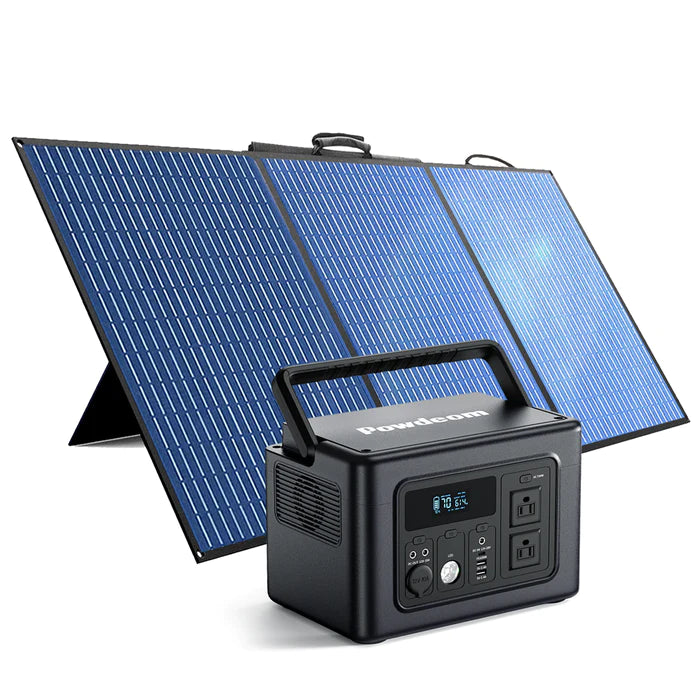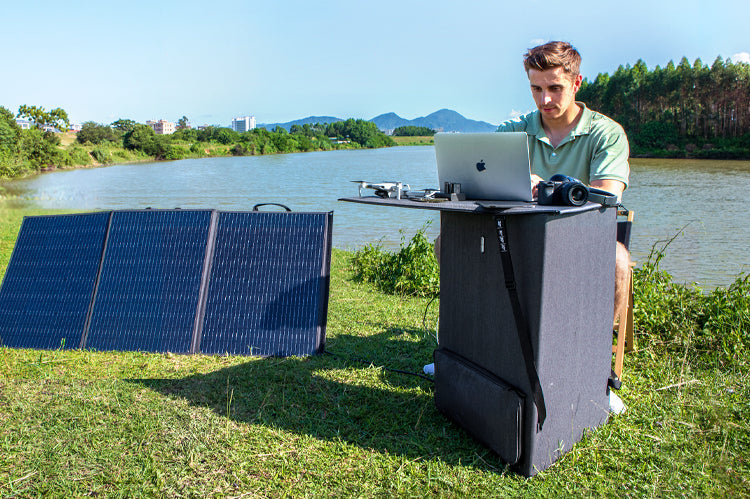Overview
Even the most optimistic proponents of solar energy acknowledge that their technology has one major drawback: it can only generate power when the sun is out. However, most people consume energy at their homes at their highest rate in the evening, when solar power is at its lowest point. But the sun shines during those off-peak hours, and solar panels may generate more than enough electricity to supply the grid during the day's peak hours. This suggests that there is a great deal of potential for both households and companies to benefit from effective solar energy storage.
What Is Solar Energy Storage?
For later use, solar batteries store the sun's rays that power the panels. An inverter is an optional component of a solar battery's integrated system for storing and delivering electricity. The amount of solar energy stored in a battery is proportional to its capacity.
The depth of discharge (DoD) is often used as a proxy for a battery's usable energy storage capacity. In the case of a battery, for instance, 100 percent DoD means that the battery may be utilized to its full capacity. Similar to how a battery with a 94% DoD may be used for 94% of its storage capacity before needing to be recharged.
In this article, we'll closely examine solar energy storage to learn more about its uses, advantages, and operation.
What Are The Benefits Of Storing Solar Energy?
It's little wonder that solar-plus-storage systems are becoming more popular; here are just a few advantages of this setup.
- Supply In Case Of Emergency
Contrary to popular belief, solar panels cannot provide backup electricity during a blackout. Connecting your solar system to a solar battery will allow you to continue using your electricity even if the power grid is down. For this reason, states like California, where rolling blackouts are prevalent, are among the leaders in adopting energy storage systems.
In addition to being a more eco-friendly and cost-effective alternative to gas-powered generators, solar batteries also produce far less noise. And the energy produced by solar panels is immediately usable; there's no need to wait for a battery to recharge.
- Energy Autonomy
Your reliance on the public power grid may be reduced if you have solar energy storage. We already know that this will keep you safe in the event of a grid power outage, but it will also make you less reliant on the utility in the long run.
Solar energy storage, for example, shields you from the annually almost certain hikes in your electric bill. Power may be drawn from a battery rather than the grid, saving money.
What's more, you're not in the dark about the origins of your energy supply. Foreign gas and oil may be used to produce energy at a utility. Solar energy generated by panels installed on your roof means you may turn in peace.
- Reduced Electric Bills
The utility pricing system known as net metering prevents a solar battery from saving you money on your power bill in many areas. If your house generates more solar power than it needs, the utility company must pay you the full retail cost for the energy you don't use. The service acts as your "financial battery," in a way.
While some utilities may buy back surplus solar power at a discount, others only provide retail net metering. Solar energy storage may help reduce costs even more by preventing energy waste. If you have more power than you need, rather than transferring it to the grid and being paid a pittance, you may store it for later use and get paid the full retail amount.
Solar storage is particularly useful if your utility charges more for electricity during peak demand based on the time of day. If you have a battery, you may use it to power your home during peak hours when utility costs are higher.
- Lessening Your Impact On The Environment
In many parts of the globe, utilities still rely heavily on polluting fossil fuels to generate the vast majority of their electricity. This implies that you are likely contributing to the combustion of fossil fuels for every kilowatt-hour energy you consume from your utility.
When you install a solar energy storage system, however, you can put all of the power your panels generate to good use. Clean energy sources, such as solar, reduce harmful pollutants and contribute to a more pleasant and sustainable earth.
How Is Solar Energy Stored?(Battery, Thermal, Mechanical)
There are three main types of solar energy storage: mechanical, thermal, and battery. In this article, we will examine both of them in brief.
Battery Storage Entail
When it comes to home solar systems, batteries are by far the most popular means of storing energy. The chemical interaction between the battery's components keeps energy when sunlight is poured into the battery.
When the battery is depleted, the reaction is inverted, enabling current to flow out of the battery. The widespread use of lithium-ion batteries in solar applications, coupled with the fast development of new battery technologies, promises to bring forth cheaper, more scalable battery storage options.
Thermal Storage
Different substances, such as water or molten salt, are used to store solar energy to absorb and store the sun's warmth for later use. The energy is then used, often to boil water in power plants, and the heated medium is kept in an insulated tank until then.
Mechanical Storage
Mechanical energy storage uses an object's potential energy to create electricity. To store excess electricity for later use, mechanical storage technologies turn it into mechanical power and then back into electricity. These are the three most common types of mechanical energy storage systems:
- Flywheel
This strategy employs the usage of a flywheel, which is spun by excess power during low-demand periods and then used to deliver energy quickly during high-demand periods.
- Pumped hydro
In a pumped hydro system, water is transported through a pump to a reservoir above turbine generators. When energy demand is strong, the water is permitted to run freely through turbines.
- High-pressured air
Compressed air is forced into a huge container, such as a tank or a cave, to store the energy. During high electricity demand, the air is released to run turbines and produce power.
Technology To Help Design Solar Battery Storage
Utility applications place special importance on the design and decision of selecting the optimal battery for the power-to-energy ratio. When designing and deciding on the best battery for utility use, the power-to-energy balance of different batteries is crucial.
Batteries rated for greater power than energy may be utilized for either power applications or energy storage, and the opposite is true. Damage to the whole system and an increase in repair costs are the direct outcomes of using inappropriate battery technology.
Storage needs come in a variety of forms, including:
- Supporting activities- Consists of Frequency Control and an Operational Reserve
- Optimal shaving
- Islanding
- Variations in Renewable Energy Integration - Controlling the pace of acceleration, using variable wind and solar power.
- Best possible rotation; high power output
- Functioning as a Microgrid Component
- Long-term energy restrictions-application
- Stability, power application, and time constraints
What Are The Benefit Of Having A Battery Storage
The energy that is naturally replenished might come from the sun, the wind, or the tides. As its name implies, it has to do with making use of a plethora of renewable resources.
The most popular are renewable and environmentally friendly wind power and solar energy, but they suffer from one major shortcoming: they are not always reliable. Wind and solar electricity are intermittent sources of energy generation. Since solar electricity is abundant when there is less demand for residential lights, it is essential to store the energy in batteries to be utilized when needed.
- Facilitates increased usage of sustainable power sources
To keep electricity available whenever needed, batteries must be utilized to store it. Batteries allow you to store any energy your solar system doesn't need immediately, so you may use them instead of the grid on cloudy days when your solar system isn't producing enough electricity.
- Safety measures taken
Batteries used to store energy enable renewable energy generation and usage to be decoupled from times of low energy demand. Inconsistent generation of this energy is an intractable challenge, but these solutions let you work around that fact.
- Reduced reliance on the power grid
You may create a more secure and self-sufficient dwelling by installing a solar battery system. If you live in a remote place where the power supply is unreliable, a battery storage system may provide you peace of mind by allowing you to run essential appliances in your house independently of the grid for long periods.
- Lessen your contribution to global warming.
By incorporating solar battery storage into your lifestyle, you may lessen your household's environmental impact and become more self-sufficient. If you're looking to reduce your impact on the environment and cut down on greenhouse gasses, these solutions are for you. Using battery storage systems, you can make sure that the energy generated by solar energy systems is not wasted and that it produces less pollution than conventional fossil fuels.
- Costs reduced
The versatility also allows for significant savings on power expenses. There can be a perfect balance between solar and grid power with the lowest possible prices if homes and businesses draw electricity from the grid when it is cheaper and utilize it during peak hours (when costs may be high).
Summary
Even though the sun is a pure energy source with almost no limits, tapping into its energy may be difficult. Fortunately, commercial and household storage alternatives provide tried-and-true ways of storing solar energy, and new technologies are constantly being developed in this area.
Meanwhile, mechanical storage methods and grid-scale battery storage may help businesses make the most of solar power when required. Several reasonably priced battery storage devices are available, making them the ideal choice for home solar systems. These options provide a strong portfolio for storing solar energy and present a compelling case for expanding solar deployment beyond industrial and institutional contexts.




